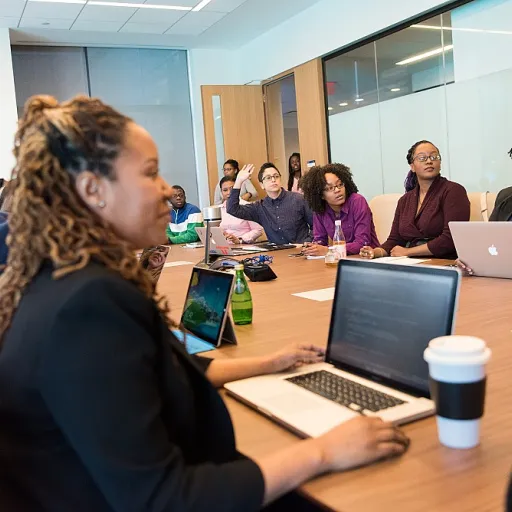
Understanding Employee Engagement
Grasping the Essence of Employee Engagement
Understanding employee engagement is crucial for any organization aiming to harness the full potential of its workforce. Employee engagement is not just about job satisfaction; it involves a deeper connection between employees and their roles, which ultimately influences their performance and the overall success of the organization.
To effectively engage talent, it's essential to conduct a thorough skills gap analysis. This helps identify the areas where employees may need more challenging tasks or additional training to enhance their skills. By understanding the specific competencies required for each job role, management can tailor tasks to better fit the abilities and aspirations of their employees.
Employee engagement is also about creating an environment where employees feel valued and motivated. This involves recognizing their contributions and providing opportunities for growth. When employees are engaged, they are more likely to take initiative, contribute innovative ideas, and remain committed to the organization in the long term.
In the subsequent sections, we will explore how to identify signs of underutilized talent and the impact of monotonous work on employee engagement. By addressing these issues, organizations can reallocate tasks effectively and encourage skill development, fostering a feedback-driven culture that supports continuous improvement.
Identifying Signs of Underutilized Talent
Recognizing Signs That Talent Is Underutilized
In the realm of effective job management, identifying when employees are not fully engaged in their roles is crucial for any organization striving to harness high potential talent. Often, subtle signs can point to talent being underserved by their current responsibilities, which can impact job satisfaction and overall performance.
Firstly, performance data and job analysis can reveal discrepancies. If an employee's performance metrics remain stagnant or begin to decline, despite no change in skills competencies, it could indicate a mismatch between their current tasks and potential. Organizations should regularly conduct effective task analysis to help identify such misalignments.
Employees might also express dissatisfaction or appear disengaged in their roles. This can manifest in behaviors such as decreased enthusiasm for routine tasks, minimal input in team discussions, or inconsistent job performance. Paying attention to these cues during performance management reviews can be pivotal in understanding whether job descriptions are meeting their strengths and aspirations.
Moreover, an exemplary candidate might become visibly restless or seek more stimulating opportunities elsewhere if they feel their capabilities are underutilized. Tracking long-term trends in workforce planning and through exit interviews can provide invaluable insights into such tendencies.
By identifying underutilized talent early, organizations can reallocate tasks more effectively, ensuring that all employees are functioning at their highest potential and enhancing overall employee experience. For companies seeking more strategies on making the most of their talent, exploring the benefits of temp-to-hire positions can offer flexible solutions. Explore the benefits of temp-to-hire positions.
The Impact of Monotonous Work on Talent
The Effects of Repetitive Roles on High-Potential Employees
Identifying when employees are caught in a cycle of monotonous work is crucial for maintaining a vibrant and productive workforce. When talented individuals are relegated to repetitive tasks, it can drain their motivation and decrease job satisfaction. This not only affects their job performance but can also stifle their potential for growth. Repetitive roles can lead to:- Decreased Engagement: Employees may feel a lack of connection to their work, causing disengagement and reducing overall productivity.
- Stunted Skill Development: Without opportunities to hone new skills, employees' talent may become stagnant, impacting long-term career progression and the organization’s talent pipeline.
- Invasion of Turnover Risks: Boredom and lack of challenge can drive high-potential employees to seek more engaging roles outside of the organization, leading to increased talent attrition.
- Reduced Innovation and Creativity: Limited variation in tasks restricts employees’ ability to bring fresh ideas and solutions to the table.
Strategies to Reallocate Tasks
Strategically Redistributing Responsibilities
To effectively engage underutilized talent and enhance job satisfaction, organizations need to consider strategic task reallocation. Identifying a clear understanding of employees' skills and potential is the first step. This involves a thorough task analysis to align job descriptions with the actual tasks employees are enthusiastic about and capable of performing.
Employ task analysis and performance management techniques to gain insights into the current role and tasks allocated to each employee. By doing so, management can conduct an effective analysis to pinpoint mismatches between job performance expectations and the skills competencies of the workforce. This will guide in redefining roles and responsibilities, ensuring tasks align with employees' strengths, ultimately benefiting organization performance.
Job satisfaction can be significantly enhanced by addressing these mismatches. When tasks are aligned with employees' skills and passions, they are more likely to perform effectively and stay motivated. Conducting job evaluations regularly can help in identifying any shifts in job performance and in making necessary adjustments in workforce planning.
To facilitate this, consider employing talent management strategies that promote a culture of continuous learning. Encouraging high potential employees to engage in additional training or take on new roles can further empower them. It's crucial for organizations to not only look at potential employees during the hiring process but to also focus on developing current employees' potential long term.
Encouraging Skill Development
Nurturing Skills for Enhanced Job Performance
Recognizing when employees are ready for more engaging tasks is pivotal, but it’s equally important to encourage the development of their skills and competencies. By fostering the right environment, organizations can ensure their workforce reaches its full potential and enhances overall job performance. Enhancing skills involves a multifaceted approach that includes adequate training, exposure to diverse tasks, and management support. Understanding the skill gaps within your team is the first step. Task analysis can help identify the specific areas where skill development is needed, ensuring that the training provided aligns with both the organization's needs and the employees' career goals. Here’s how organizations can support skill development effectively:- Offer Tailored Training Programs: Implement training sessions that are directly related to the job tasks employees are responsible for. This targeted approach not only boosts job satisfaction but also ensures employees are better prepared for new challenges.
- Provide Opportunities for Cross-Training: Allow employees to experience different roles within the organization. This not only develops a broader skill set but also gives them insight into various aspects of the business, which feeds into the understanding that underlies effective job task execution.
- Facilitate Mentorship and Coaching: Pairing employees with mentors or coaches can be instrumental in guiding their development. These relationships can provide performance management insights, helping employees focus on areas that require improvement and celebrating high potential.
- Utilize Data-Driven Assessments: Regular training needs analysis can help identify skills competencies that are most crucial for current and future tasks. By using data, organizations can conduct effective job assessments that accurately reflect the skills required for each role.
- Promote a Culture of Continuous Learning: Encourage employees to remain curious and pursue learning opportunities outside of formal training sessions. This could involve participating in workshops, online courses, or industry seminars.
Creating a Feedback-Driven Culture
Building a Culture of Continuous Feedback
Creating a feedback-driven culture is essential for maintaining high levels of employee engagement and ensuring that talent is effectively utilized. When employees feel heard and valued, their job satisfaction and performance improve significantly. Here are some strategies to foster a culture where feedback is a regular part of the organizational fabric:
- Regular Check-ins: Conduct regular one-on-one meetings between managers and employees. These sessions should focus on discussing job tasks, performance, and potential areas for growth. This helps identify any issues early and provides an opportunity for employees to voice their concerns or aspirations.
- Open Communication Channels: Encourage open communication across all levels of the organization. Employees should feel comfortable sharing their thoughts on their roles and tasks without fear of retribution. This openness can lead to more accurate job descriptions and better task analysis.
- 360-Degree Feedback: Implement a 360-degree feedback system where employees receive feedback from peers, subordinates, and supervisors. This comprehensive view helps in understanding the skills and competencies of each employee and can highlight areas for improvement or further development.
- Data-Driven Insights: Use data analysis to track employee performance and engagement levels. This can help identify trends and patterns, allowing management to make informed decisions about task reallocation and training needs.
- Recognition and Rewards: Recognize and reward employees who demonstrate high potential and contribute positively to the organization. This not only boosts morale but also encourages others to strive for excellence.
By embedding these practices into the organizational culture, companies can ensure that their workforce remains motivated and aligned with the organization's goals. A feedback-driven culture not only enhances employee experience but also supports long-term talent management and workforce planning.












